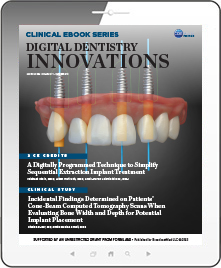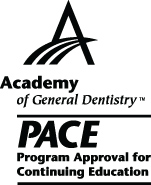CDEWorld > eBooks > Digital Dentistry Innovations


ADA CERP is a service of the American Dental Association to assist dental professionals in identifying quality providers of continuing dental education. ADA CERP does not approve or endorse individual courses or instructors, nor does it imply acceptance of credit house by boards of dentistry. Concerns or complaints about a CE provider may be directed to the provider or to ADA CERP at www.ada.org/cerp/

Approved PACE Program Provider. FAGD/MAGD credit. Approval does not imply acceptance by a state or provincial board of dentistry, or AGD endorsement. 1/1/2023 to 12/31/2028. ID # 209722.
eBook
Released: Tuesday, March 7, 2023
Expires: Tuesday, March 31, 2026
Digital Dentistry Innovations
Commercial Supporter: Formlabs
This thematic CDEWorld eBook on digital dentistry offers a continuing education (CE) article on the use of digital technologies to simplify sequential extraction therapy for full-arch rehabilitation cases. This eBook also includes a report of a clinical study on incidental dentoalveolar findings of potential pathology in otherwise asymptomatic patients, as detected by cone-beam computed tomography (CBCT). Download to earn 2 FREE CEU now!
FEATURED CONTENT
CE: A Digitally Programmed Technique to Simplify Sequential Extraction Implant Treatment
Michael Klein, DDS; Allon Waltuch, DDS; and Lauren Lehrfield, BSc, RDH
While there are multiple approaches to full-arch implant treatment, methods that can reduce the number of dental appointments, limit the number of surgical interventions, and shorten overall treatment time are preferred by both patients and clinicians. This article describes a technique for streamlining sequential extraction therapy to reduce patient chair-time and simplify treatment through the use of digital tools and technologies and contemporary materials.
Credits: 2 Self-Study CEU
Cost: $0
Provider: Conexiant Education
Incidental Findings Determined on Patients’ Cone-Beam Computed Tomography Scans When Evaluating Bone Width and Depth for Potential Implant Placement
Chelsea Herr, BS; and Douglas Smail, DDS
This clinical study was conducted to document the incidence of radiographic dentoalveolar findings of potential pathology in otherwise asymptomatic patients. This study demonstrates the importance of CBCT in capturing not only the area of interest but also other oral regions for the comprehensive care of patients.


